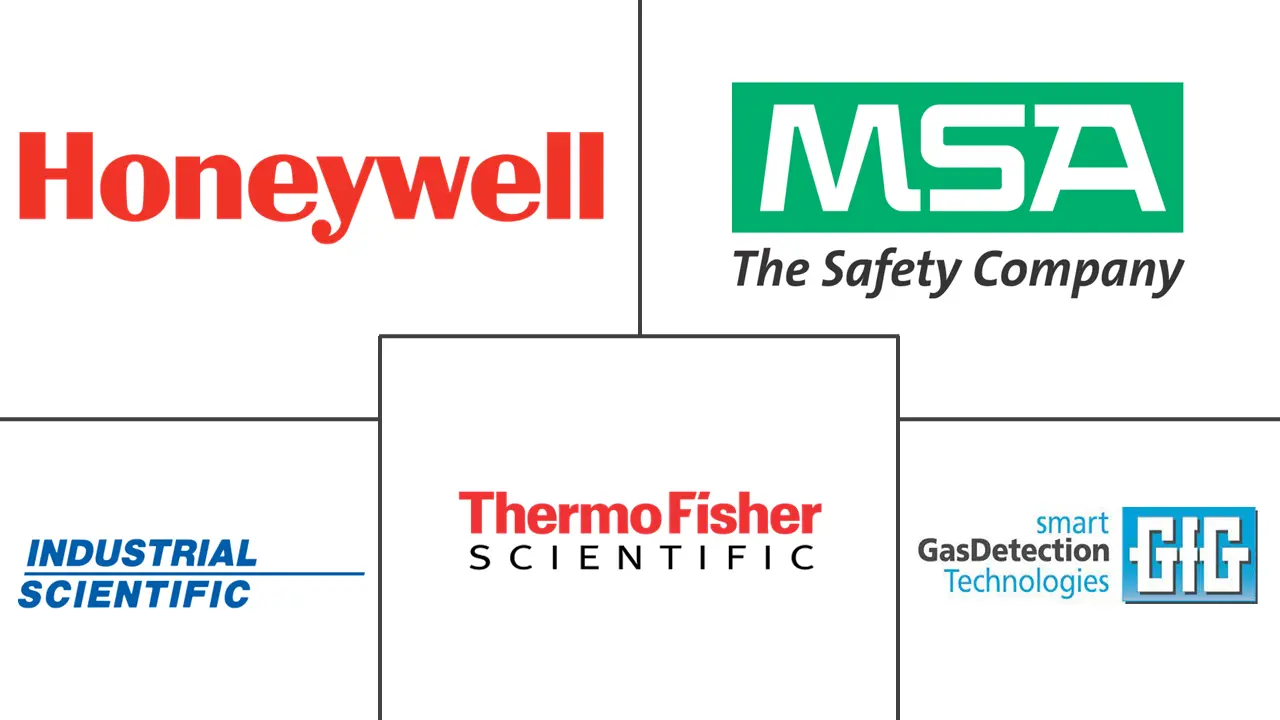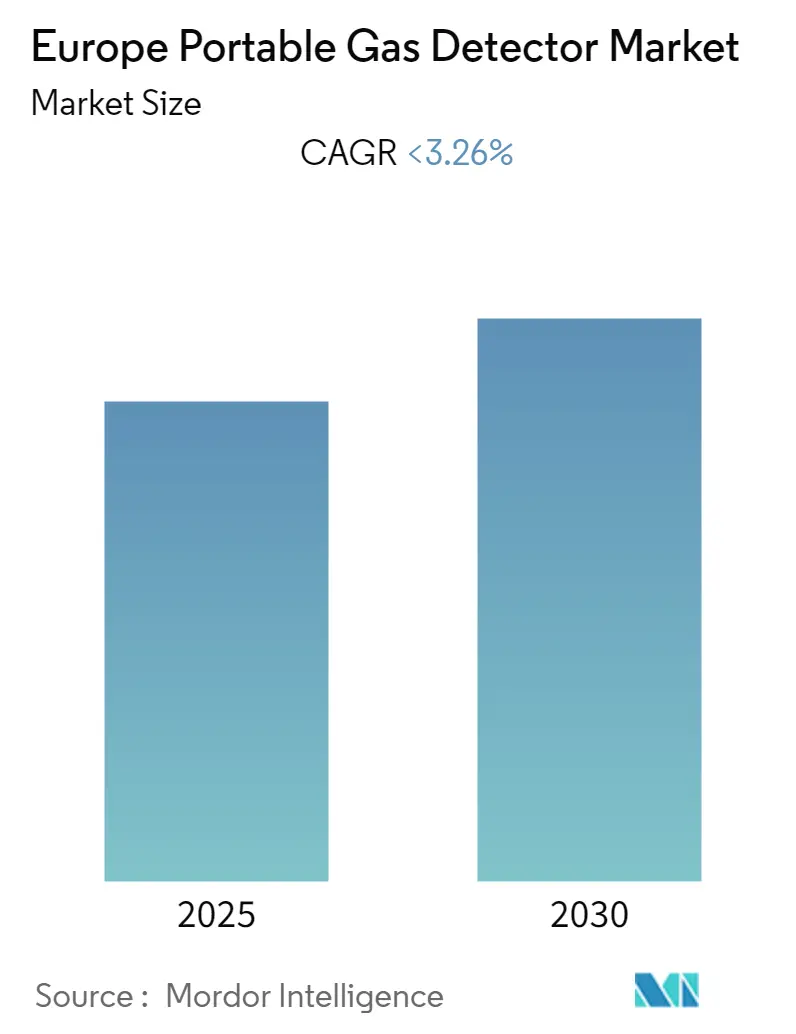
Europe Portable Gas Detector Market Analysis by Mordor Intelligence
The Europe Portable Gas Detector Market is expected to register a CAGR of less than 3.26% during the forecast period.
- As accidental gas leaks pose a considerable threat to properties, the environment, and human life, portable gas detectors play a crucial role in ensuring workplace safety across various industries. These devices are used for combustible or toxic gas detection and oxygen deficiency monitoring, especially in confined spaces.
- The increased demand for gas detectors combined with Internet of Things (IoT) and artificial intelligence (AI) solutions to enable anticipatory maintenance and the increased necessity for real-time data processing and delivery alerts during gas leaks are boosting the market's growth. Furthermore, the growing demand also encourages the vendors to launch new products in the European market.
- For instance, in September 2022, Blackline Safety Corp., which has offices in the United Kingdom and France, launched a revolutionary connected wearable for single-gas detection. G6, a completely linked and intuitive system that uses the most recent Internet of Things (IoT) mobile connectivity, offers enhanced advantages, including longer battery life, a cheaper cost of ownership, and fewer false alarms.
- Compared to other regions, the regulations concerning overall environmental emissions are relatively more stringent. The government regulates the leakage of such gases, which drives the demand for gas detectors. For instance, the EU-incorporated Directive 2010/75/EU is an instrumental regulation concerning the control of pollutant emissions into the atmosphere by industrial installations.
- However, the primary issue in manufacturing gas detectors is that the devices often need help to identify dangerous gasses and, more critically, to distinguish between harmful and non-hazardous gasses, resulting in uncertainty in operations and periodic false signals. Furthermore, the requirement of various sensors to detect different types of gasses also impacts the overall cost of the device.
- The COVID-19 outbreak has had a notable impact on the growth of the studied market, as the European region, especially countries like Italy, the United Kingdom, Germany, etc., reported a large number of infection cases. The widespread lockdown imposed as a result significantly disrupted the industrial sector, resulting in a slowdown in the demand for these devices. However, with the industrial sector starting to recover, the studied market is expected to witness an upward growth trend during the forecast period.
Europe Portable Gas Detector Market Trends and Insights
Oil and Gas Segment to Offer Market Growth Opportunities
- The oil and gas industry will significantly impact the market as additional gas field discoveries translate into higher demand for such portable detectors. Multi-gas detectors are gaining popularity over traditional kinds due to their small form and better gas-detecting aspects. The increasing consumption of oil and gas also favors the growth of the studied market. For instance, according to BP, the annual oil consumption in Europe and the CIS increased from 791.7 million metric tons in 2020 to 831.4 million metric tons in 2021.
- Increasing incidences of gas leaks across European countries will contribute to market demand as companies are increasingly focusing on using advanced equipment to make the process highly effective and efficient. For instance, in June 2021, the Clean Air Task Force (CATF) used infrared cameras to capture over 120 cases of methane emissions escaping from oil and gas activities in seven European countries, including Germany, Italy, Romania, Hungary, the Czech Republic, Austria, and Poland.
- Furthermore, as a result of several government programs and regulations supporting the use of such devices, the oil and gas sector is likely to be among the region's most significant users of gas detectors. In June 2022, at the Major Economies Forum on Energy and Climate, a GMP Energy Pathway was announced to expedite methane pollution decreases in the conventional power sector.
- Moreover, according to the International Energy Agency, by utilizing existing technologies, the oil and gas sector could reduce methane pollution by 75% by 2030. This, in turn, is expected to increase the awareness of adopting gas detection technologies in the European region over the coming years.
Furthermore, increasing government investments in the oil and gas sector, especially since the outbreak of the Russia-Ukraine dispute, are expected to increase the demand for portable gas detectors across the region over the forecast period. In May 2022, the European Commission launched a 210-billion-euro (USD 220 billion) strategy to wean Europe off Russian fossil resources in five years and accelerate its transition to renewable energy.
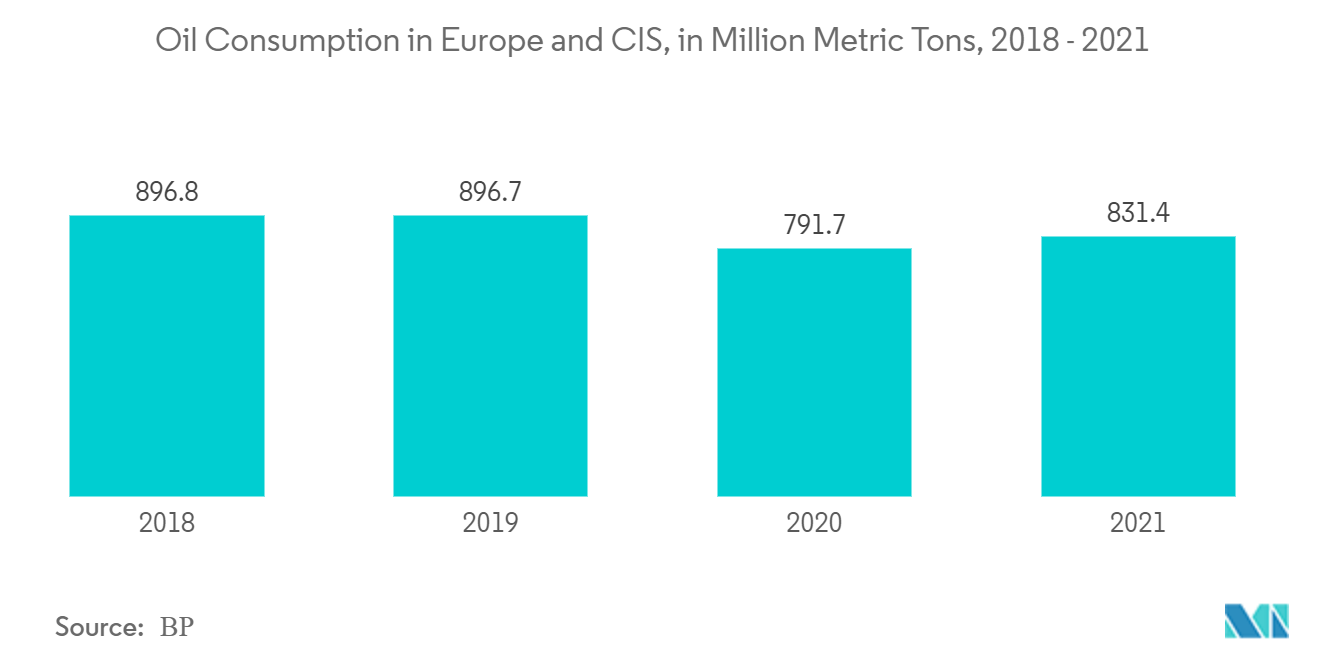
United Kingdom to Hold a Significant Market Share
- The country's stringent regulatory restrictions for emissions throughout industries that boost workplace safety have increased the demand for diverse gas detector applications. The monitoring of the surroundings connected with workers' exposures to hazardous conditions such as gasses, noise, dust, and others is managed in the United Kingdom by COSHH (Control of Substances Hazardous to Health Regulations).
- In the United Kingdom, concentrations of key pollutants in outdoor air are regulated by the Air Quality Standards (Wales) Regulations 2010, the Air Quality Standards (Northern Ireland) Regulations 2010, and the Air Quality Standards (Scotland) Regulations 2010. The government has actively been making amendments to make these regulations more effective, supporting the market's growth. For instance, the UK government's latest climate change target calls for an emissions reduction of 78% by 2035 compared to 1990 levels.
- Furthermore, the presence of significant players in the gas detector industry, including Crowcon Detection Instruments Ltd. and GFG Europe Trolex Ltd., headquartered in the UK, also supports the studied market's growth. Furthermore, the area is seeing the majority of technological breakthroughs, and the implementation of IIoT in various sectors is projected to benefit the market.
- Innovative product launches by market players operating in the regional market will contribute to market development. For instance, in September 2022, DraegerSafety UK, a market leader in safety and medical technology, introduced the X-am 2800, a novel portable gas detector, to its wide safety and gas detecting range. Since mobile gas detectors are carried on the body, durability is critical to their operational reliability.
The United Kingdom is also among the largest consumers of petroleum products in the European region and has several industries operating in the sector. Considering the higher degree of emissions associated with these industries, the demand for portable gas sensors is expected to remain high. According to BP, the United Kingdom's oil consumption in 2021 will be 57.3 million metric tons.
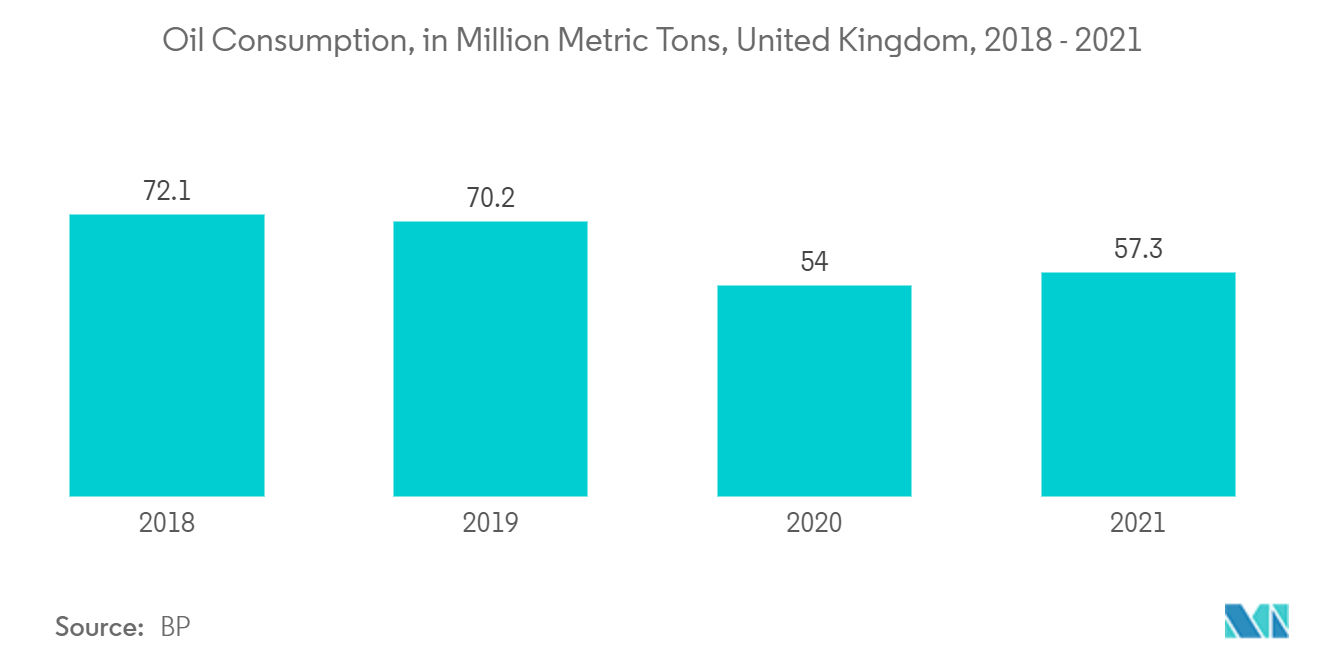
Competitive Landscape
The European portable gas detector market is moderately competitive, with the presence of several players offering multiple products. Some of the major players operating in the market include Honeywell International Inc., MSA, Thermo Fisher Scientific Inc., Industrial Scientific, and GfG Gas Detection, among others. These players are adopting strategies such as product launches, product innovation, mergers, and acquisitions, along with partnerships, to capture more market share.
In November 2022, ION Science, a UK-based company, introduced the Tiger XT series of portable VOC detectors, which provide consumers with improved efficiency and durability. The newest detector series maintains all of the market-leading benefits of its predecessors, the Tiger range, and includes three models: the Tiger XT compact VOC detector, the entry-level Tiger XTL portable VOC gas detector, and the Tiger XT Select benzene detector.
In November 2022, IGD announced the availability of the 903-X5. With dual gas detection capacities and a choice of 400 plug-replaceable sensors, it includes IGD's long-life PID and poison-resistance MK8 Pellistor. This detector satisfies all gas identification requirements and is offered by IGD with service, training, and installation.
Europe Portable Gas Detector Industry Leaders
-
Honeywell International Inc.
-
Thermo Fisher Scientific Inc.
-
Industrial Scientific
-
GfG Gas Detection
-
MSA Safety Incorporated
- *Disclaimer: Major Players sorted in no particular order
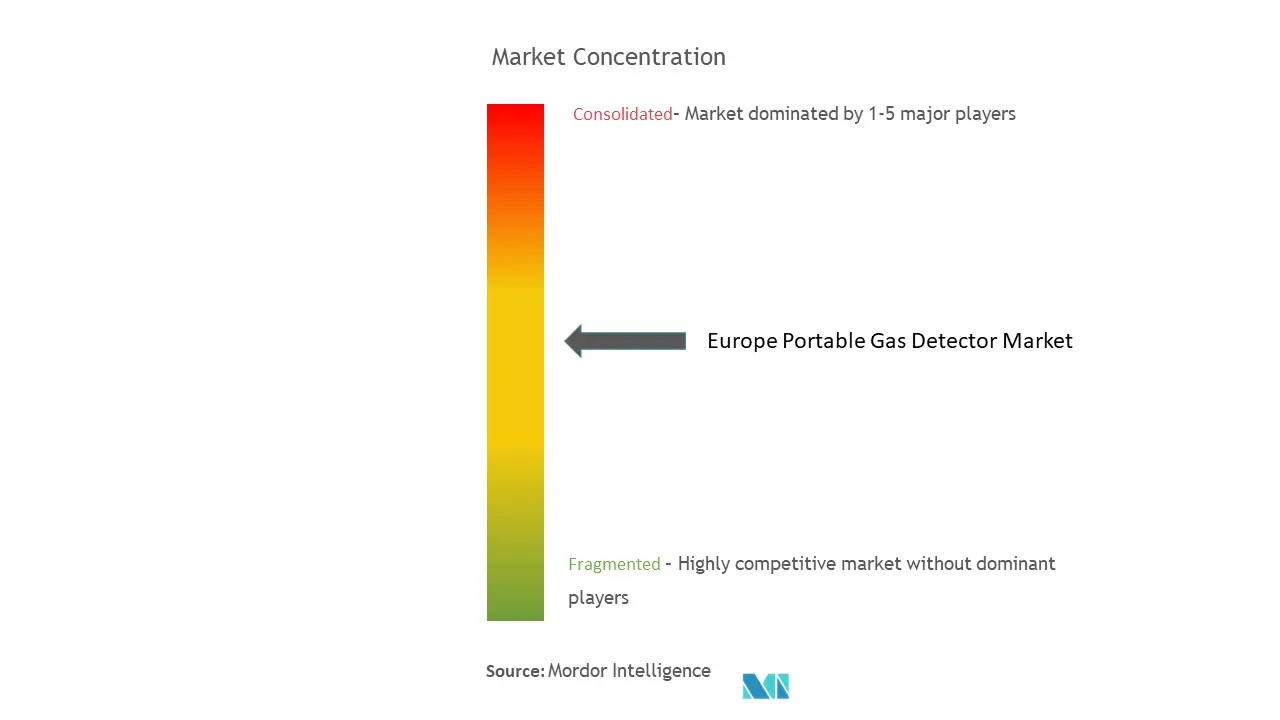
Recent Industry Developments
- September 2022 : Blackline Safety Corp. announced the release of the G6 single-gas detector, establishing a new trend in linked employee wearables. Blackline's latest product, the G6 single-gas sensor, is designed for petrochemical, oil and gas, and other industrial sectors, allowing for faster incident reaction time, excellent safety and compliance, long-term connection, and increased efficiency.
- August 2022 : Riken Keiki Co., Ltd. announces the release of the GX-Force portable four-gas detector. By using built-in pumping aspiration, the GX-Force can identify combustible gases, Oxygen, and poisonous chemicals (Carbon monoxide and Hydrogen sulfide) that trigger explosion/Oxygen deficiency/poisoning catastrophes promptly and reliably.
Europe Portable Gas Detector Market Report Scope
Portable gas detectors use various methods to detect and display the number of specific gasses in the air. These are largely battery-powered devices for safety concerns and are usually used to avoid hazardous contamination and fire. Portable gas detectors identify excessive amounts of gasses by using audible or visible signs, including lights, alarms, or any combination of signals.
The study analyzes trends, market estimations, and projections by tracking the revenue accrued from the portable gas detector sale. Fixed gas detections, gas analyzers, and gas sensors are excluded from the scope of the study. The European portable gas detector market is segmented based on product type, end-use industry, and country. The study also analyzes the impact of COVID-19 on the European portable gas detector market. The market sizes and forecasts are provided in terms of value (USD million) for all the above segments.
| Single-gas |
| Multi-gas |
| Oil & Gas |
| Chemicals & Petrochemical |
| Water & Wastewater |
| Power Generation & Transmission |
| Metal & Mining |
| Other End User Industries |
| Germany |
| United Kingdom |
| France |
| Rest of Western Europe |
| Central & Eastern Europe |
| By Type | Single-gas |
| Multi-gas | |
| By End-user Industry | Oil & Gas |
| Chemicals & Petrochemical | |
| Water & Wastewater | |
| Power Generation & Transmission | |
| Metal & Mining | |
| Other End User Industries | |
| By Geography | Germany |
| United Kingdom | |
| France | |
| Rest of Western Europe | |
| Central & Eastern Europe |
Key Questions Answered in the Report
What is the current Europe Portable Gas Detector Market size?
The Europe Portable Gas Detector Market is projected to register a CAGR of less than 3.26% during the forecast period (2025-2030)
Who are the key players in Europe Portable Gas Detector Market?
Honeywell International Inc., Thermo Fisher Scientific Inc., Industrial Scientific, GfG Gas Detection and MSA Safety Incorporated are the major companies operating in the Europe Portable Gas Detector Market.
What years does this Europe Portable Gas Detector Market cover?
The report covers the Europe Portable Gas Detector Market historical market size for years: 2019, 2020, 2021, 2022, 2023 and 2024. The report also forecasts the Europe Portable Gas Detector Market size for years: 2025, 2026, 2027, 2028, 2029 and 2030.
Page last updated on:
Europe Portable Gas Detector Market Report
Statistics for the 2025 Europe Portable Gas Detector market share, size and revenue growth rate, created by Mordor Intelligence™ Industry Reports. Europe Portable Gas Detector analysis includes a market forecast outlook for 2025 to 2030 and historical overview. Get a sample of this industry analysis as a free report PDF download.
